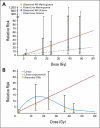Second neoplasms in survivors of childhood cancer: findings from the Childhood Cancer Survivor Study cohort
- PMID: 19255307
- PMCID: PMC2738645
- DOI: 10.1200/JCO.2008.21.1920
Second neoplasms in survivors of childhood cancer: findings from the Childhood Cancer Survivor Study cohort
Abstract
Purpose: To review the reports of subsequent neoplasms (SNs) in the Childhood Cancer Survivor Study (CCSS) cohort that were made through January 1, 2006, and published before July 31, 2008, and to discuss the host-, disease-, and therapy-related risk factors associated with SNs.
Patients and methods: SNs were ascertained by survivor self-reports and subsequently confirmed by pathology findings or medical record review. Cumulative incidence of SNs and standardized incidence ratios for second malignant neoplasms (SMNs) were calculated. The impact of host-, disease-, and therapy-related risk factors was evaluated by Poisson regression.
Results: Among 14,358 cohort members, 730 reported 802 SMNs (excluding nonmelanoma skin cancers). This represents a 2.3-fold increase in the number of SMNs over that reported in the first comprehensive analysis of SMNs in the CCSS cohort, which was done 7 years ago. In addition, 66 cases of meningioma and 1,007 cases of nonmelanoma skin cancer were diagnosed. The 30-year cumulative incidence of SMNs was 9.3% and that of nonmelanoma skin cancer was 6.9%. Risk of SNs remains elevated for more than 20 years of follow-up for all primary childhood cancer diagnoses. In multivariate analyses, risks differ by SN subtype, but include radiotherapy, age at diagnosis, sex, family history of cancer, and primary childhood cancer diagnosis. Female survivors whose primary childhood cancer diagnosis was Hodgkin's lymphoma or sarcoma and who received radiotherapy are at particularly increased risk. Analyses of risk associated with radiotherapy demonstrated different dose-response curves for specific SNs.
Conclusion: Childhood cancer survivors are at a substantial and increasing risk for SNs, including nonmelanoma skin cancer and meningiomas. Health care professionals should understand the magnitude of these risks to provide individuals with appropriate counseling and follow-up.
Conflict of interest statement
Authors' disclosures of potential conflicts of interest and author contributions are found at the end of this article.
Figures


References
-
- Meadows AT, D'Angio GJ, Evans AE, et al. Oncogenesis and other late effects of cancer treatment in children. Radiology. 1975;114:175–180. - PubMed
-
- Meadows AT, D'Angio GJ, Mike V, et al. Patterns of second malignant neoplasms in children. Cancer. 1977;40:1903–1911. - PubMed
-
- Tucker MA, Meadows AT, Boice JD, et al. Leukemia after therapy with alkylating agents for childhood cancer. J Natl Cancer Inst. 1987;78:459–464. - PubMed
-
- Robison LL, Mertens AC, Boice JD, et al. Study design and cohort characteristics of the childhood cancer survivor study: A multi-institutional collaborative project. Med Pediatr Oncol. 2002;38:229–239. - PubMed
Publication types
MeSH terms
Grants and funding
LinkOut - more resources
Full Text Sources

